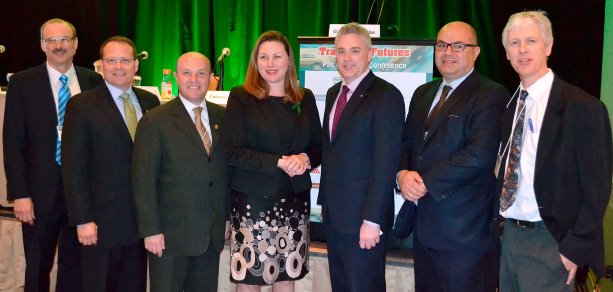Provincial politicians of every stripe recently weighed in on various aspects of public-private partnerships (P3s) during the Transport Futures P3s in Motion Conference, with the auditor general’s report shaping much of the debate.
Liberal MPP Peter Milczyn, who is the parliamentary assistant to the minister of economic development, employment and infrastructure, NDP Critic for Finance and the Treasury Board MPP Catherine Fife, PC Transportation Critic MPP Michael Harris and Ontario Green Party leader Mike Schreiner were asked to take part in a panel discussion on P5s: Political Perspectives on P3s.
Anticipating that Auditor General Bonnie Lysyk’s 2014 annual report would come up, Milczyn was quick to defend the P3 model and how it benefits Ontarians. Her report claimed P3s cost taxpayers $8 billion more than if the infrastructure was built using the traditional model.
"We more than offset that with savings against the risks that would have been associated to government and taxpayers," he said. "The AFP (Alternative Financing and Procurement) is used judiciously. There is no disagreement that we need to do the best possible job to assess value for money. The majority of construction projects in this province continue to be delivered through more traditional procurement. There’s more than enough room for both models."
Lysyk looked at 74 infrastructure projects where Infrastructure Ontario (IO) used the P3 model since 2005. IO stated it was a more "cost effective" approach. She found it wasn’t actually saving taxpayers’ money, with the majority of the $8 billion cited ($6.5 billion) relating to private sector financing costs.
"I think it’s really interesting what kind of studies the government decides to listen to and what they don’t listen to," stated Fife. "She (Lysyk) found that there was no empirical data supporting the key assumptions used by Infrastructure Ontario to assign costs to specific risks. New Democrats are not completely against P3s, we just want to make sure that there’s a strong business case going forward."
Harris pointed out there was more to Lysyk’s report that should be clarified.
"I think it’s important to mention that it was the auditor general that admitted the analysis was based on the assumption that traditional procurement would have delivered the projects on time and on budget, which is rarely the case," he said.
"The evidence is clear, P3s are the most efficient and cost-effective way to build infrastructure. It’s hard to deny that P3s are in fact the future. P3s are the answer not the problem."
Schreiner says it’s not that clear cut.
"One of the concerns I have…it seems as if we are increasingly in a political culture where the public sector is demonized," he added, stating P3s need to be carefully evaluated.
"That somehow it can’t be delivered on time, on budget, efficiently, effectively."
With $130 billion committed to public infrastructure over 10 years, Milczyn added the P3 model will help get these projects underway and alleviate some of the risks that go along with large projects.
"The AFP model is about how we allocate risks. There needs to be a strong role for the private sector to ensure that these projects are delivered on time and on budget and meet the requirements that are set out," he explained. "In a properly run AFP, because the risk is transferred to the contractor, you don’t end up with that litigation and that argument."
He also stated often times projects come in under budget.
"IO is very conservative in its estimating, so that there are no nasty surprises later on (overruns)," he said.
"When you come in under, that means you have money left over to do the next project."
This was simply a poor use of taxpayer dollars, Fife retorted.
"That’s why we’re in so much trouble. If you’re building a 30 per cent cost overrun into all of your expenditures and then saying you can do things on budget and on time, that is not responsible," she said.
"The government is more interested in the politics. There’s a $130 billion at stake here. We have to be really clear about how infrastructure projects are being prioritized. We can’t afford to not get this right."
Both Schreiner and Harris stated sound decisions are needed when looking at P3s.
"We have to remove the politics out of some of these bigger decisions as well," Harris said.
"We have to make smart decisions. It has to start with an honest and transparent conversation," Schreiner stated.
"We have to make sure we fix the P3 model in Ontario. It should be good policy not bad politics that drives our decisions."



Recent Comments
comments for this post are closed